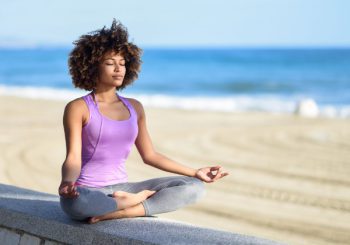 By Nick Polizzi
By Nick Polizzi
Guest Writer for Wake Up World
As meditation becomes more mainstream these days, people are finally beginning to experience not just the mental benefits of this ancient practice, but also the positive effects on their physical health. With so many different styles geared toward specific goals and outcomes, it’s not always easy to pinpoint where to start.
To help you choose a meditation that is right for your unique body and mind, we’ve shared 3 simple methods below:
Focused Meditation
The first kind involves concentrating or focusing your attention on a single object, which is commonly the breath, but could be anything, like an image, a sound, a mantra or phrase, a part of the body, etc. Most people who start out begin by focusing on the breath, because it’s something we all do naturally and once we settle down, it’s fairly easy to tune into it.
The idea is to develop the ability to remain focused on that object consistently, and for longer periods of time, regardless of what is transpiring on the “outside” during the session. Naturally, you become less and less distracted by external stimuli, and the better you get at it, the more this translates to other parts of your life, outside of your meditation routine.
Guided meditation can fall under this category, where the difference is that the you are led, by a teacher, or by a recording of that person. As you become better at remaining focused, you gradually become less and less dependent on the teacher, or recording.
The most well known type of focused meditation is Transcendental Meditation, which many people swear by, especially in the western world. Other examples include Buddhist Meditation (Samatha), Loving Kindness, Kundalini, Pranayama, and certain forms of QiGong.
Open Meditation
In this case, instead of focusing on a single object, the idea is to keep the mind open, and allow our consciousness to be aware of everything that is happening without making a passing judgment. Think of how many things can float through a river, or across the sky if you were an observer.
You can actually acknowledge what you see, hear, feel or sense otherwise, and let it all register, but the idea is to allow each object, memory or feeling to continue on its trajectory, so that you don’t actually become attached to it or fixated upon it. As you improve upon this practice, you’ll develop the ability to NOT react, and be at peace with whatever arises both inside the session, and more importantly, outside the session, in your daily life.
Examples include Vipassana and some types of Taoist Meditation, along with the Zen sitting practice of Zazen.
A Little Bit of This, A Little Bit of That
Other types of meditation usually combine both open and focused meditation in different ways, and with different techniques based on what culture or tradition they come from, and on the desired goal or outcome of the practice.
Mindfulness is a great example whereby someone focuses on a single object, but is also aware of their surroundings as the same time. The beauty here is that the mind and consciousness are both active but in a calm state, and the practitioner isn’t necessarily limited to a specific physical space, like a meditation room, or confined to be in solitude. After a certain point, you can practice it at work, in your car, while in the presence of others, or while simply enjoying life outside your home.
There are many successful and famous people, at the top of their respective fields, who practice different kinds of meditation. Oprah Winfrey, Russell Simmons and Jerry Seinfeld swear by Transcendental Meditation, while Ford Motors CEO Bill Ford uses a loving-kindness meditation practice, and Phil Jackson, the former coach of the Chicago Bulls and LA Lakers, practices Zen Buddhism. An important point is that they all have been meditating for many years, before becoming successful – and not the other way around.
It’s only a matter of time, and a matter of playing around and testing things out based on your needs, before you find a routine that you swear by too.
Stay curious,
Nick Polizzi
Recommended articles by Nick Polizzi:
- Two Sacred Medicine Trees of North America
- Staying Centered in a Wild World
- Healing in Your Sleep
- 5 Delicious and Calming Foods (and Recipes!)
- 3 Ways to Heal Trauma
- 3 DIY Practices to Pamper Your Body and Spirit
- 7 Anti-Aging Secrets from Ancient India
- 3 Ancient Medicines That Already Live in Your Home
- 4 Hidden Toxins That Can Silently Destroy Your Health
- 3 Ways to Eliminate Toxins From the Air You Breathe
About the author:
 Nick Polizzi has spent his career directing and editing feature length documentaries about natural alternatives to conventional medicine. Nick’s current role as director of “The Sacred Science” documentary and author of “The Sacred Science: An Ancient Healing Path For The Modern World” stems from a calling to honor, preserve, and protect the ancient knowledge and rituals of the indigenous peoples of the world.
Nick Polizzi has spent his career directing and editing feature length documentaries about natural alternatives to conventional medicine. Nick’s current role as director of “The Sacred Science” documentary and author of “The Sacred Science: An Ancient Healing Path For The Modern World” stems from a calling to honor, preserve, and protect the ancient knowledge and rituals of the indigenous peoples of the world.
For more, visit www.thesacredscience.com (where this article first appeared.)

If you've found value in our articles, we invite you to support the release of our brand-new book, "Gratitude Practices for Kids: A Practical Guide for Adults to Instill a Spirit of Appreciation and Positivity in the Next Generation."
"Gratitude Practices for Kids" brings together over 25 innovative and accessible practices designed to enhance gratitude in everyday life. This comprehensive guide is backed by 17 scientific studies, ensuring each concept is grounded in research, underscoring our commitment to nurturing growth, emotional intelligence, and positive interactions between adults and children.
We encourage you to opt for the paperback version to celebrate this new release. Dive into its fresh pages away from digital distractions, allowing you to immerse yourself in the transformative practices it offers.
Over recent years, Wake Up World has faced significant online censorship, which has impacted our financial ability to operate. Moving into book publishing represents a strategic step to secure the ongoing funds needed to continue our mission. By purchasing Gratitude for Kids, you help us keep our content free and accessible to everyone, avoiding needing a paywall. With over 8,500 articles published in the last 13 years, we remain dedicated to keeping our valuable content open to all.





